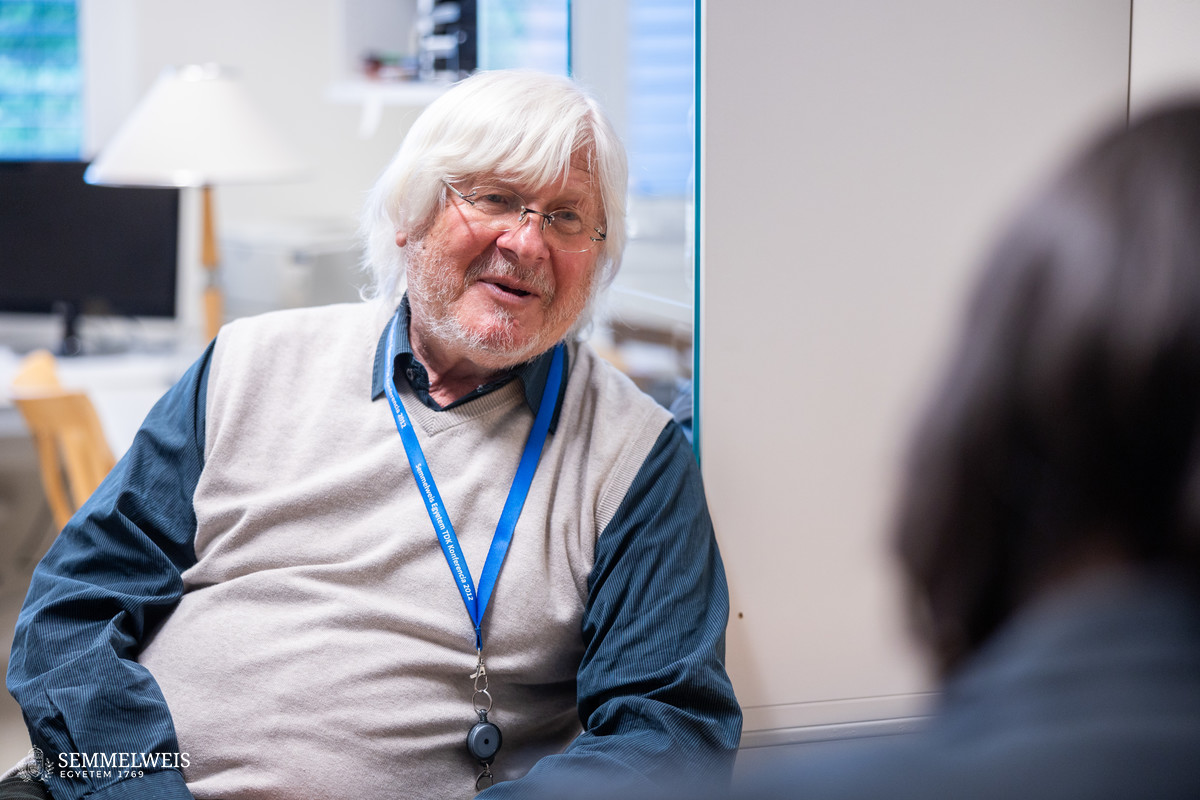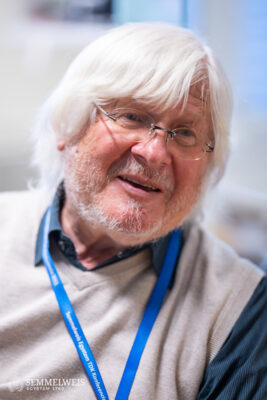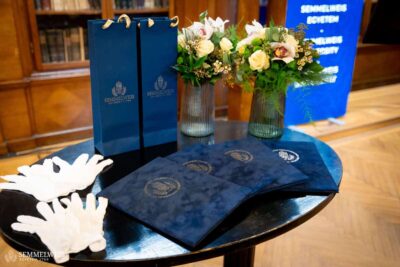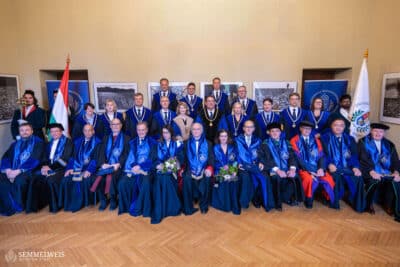 “Perseverance, an uncompromising attitude, and if you know what you want and you know it is possible to do what you set out to do, then do it. And by all means, learn to change your perspective and learn from your failures,” Dr. Miklós Zrínyi advises students, using his own example. Dr. Miklós Zrínyi is a chemistry graduate and member of the Hungarian Academy of Sciences who received the Széchenyi Prize in the Parliament Building in Budapest on the occasion of the national holiday. The professor emeritus of the Department of Biophysics and Radiation Biology, founder of the department’s Nanochemistry Research Group, and former researcher at the Department of Pharmaceutics, received the award – according to the laudation – in recognition of his valuable scientific career, the establishment of the discipline of magnetic nanoparticle-controlled gel systems, his achievements in polymer gel research, as well as the fact that he established broad international collaborations while carrying out his duties as a researcher, lecturer, and public professional. His research interests include the physical chemistry of colloidal nanosystems; functional soft materials; the mechanical, thermodynamic, and biomedical properties of polymer gels; as well as controlled drug delivery.
“Perseverance, an uncompromising attitude, and if you know what you want and you know it is possible to do what you set out to do, then do it. And by all means, learn to change your perspective and learn from your failures,” Dr. Miklós Zrínyi advises students, using his own example. Dr. Miklós Zrínyi is a chemistry graduate and member of the Hungarian Academy of Sciences who received the Széchenyi Prize in the Parliament Building in Budapest on the occasion of the national holiday. The professor emeritus of the Department of Biophysics and Radiation Biology, founder of the department’s Nanochemistry Research Group, and former researcher at the Department of Pharmaceutics, received the award – according to the laudation – in recognition of his valuable scientific career, the establishment of the discipline of magnetic nanoparticle-controlled gel systems, his achievements in polymer gel research, as well as the fact that he established broad international collaborations while carrying out his duties as a researcher, lecturer, and public professional. His research interests include the physical chemistry of colloidal nanosystems; functional soft materials; the mechanical, thermodynamic, and biomedical properties of polymer gels; as well as controlled drug delivery.
Many chemical phenomena are interpreted by science using the laws of physics, and physical chemistry is in many ways similar to biophysics, with much of the theoretical apparatus being perfectly identical, it is only their goals that are different; biophysics is concerned mainly with biological and physiological applications. According to the professor, the chemical basis of nanotechnology has been well-known for more than 150 years, with the first breakthrough coming from Michael Faraday when he produced gold colloids. The branch of science long known as colloid chemistry was somewhat overshadowed until technological advances brought it to the fore again 20-30 years ago. Colloid chemistry is a field of physical chemistry that studies the characteristics and phenomena of particles in the 1-1000 nm size range. Nanochemistry is playing an increasingly important role in medical imaging, in the fabrication of artificial tissues and extracellular matrices, and in pharmaceutics for as precise drug delivery as possible.
I always wanted to be a researcher because I was driven by curiosity and a desire to understand. If it hadn’t been so, and if I had been interested in industry, I would have chosen the Budapest University of Technology (BME).
Throughout his career Dr. Miklós Zrínyi has always taught in addition to basic research in physical chemistry. Later, however, after graduating in chemistry from Eötvös Loránd University (ELTE) and spending a period of so-called postgraduate fellowship in the Department of Colloid Chemistry – now called doctoral studies -, he went on to work at BME.
 I spent a third of my long professional career at ELTE, a third at the Budapest University of Technology, where I was head of the Department of Physical Chemistry and also served as vice-rector for international affairs, and a third at Semmelweis University, the professor said. During his years at BME, he obtained several patents. These brought scientific recognition and high citation rates, but in the end they were not utilized on the market, Dr. Miklós Zrínyi noted. I came to Semmelweis University in 2008, at the invitation of the former rector, Dr. Tivadar Tulassay. I worked at the Department of Pharmaceutics and later at the Department of Biophysics and Radiation Biology, from where I retired, and as professor emeritus I now teach basic courses at the department, he added. He also teaches a basic course in physical chemistry at the Babeș-Bolyai University in Cluj-Napoca, and PhD courses in English at Jiaotong University in Xi’an, China. As he said, the mentality of Chinese and Hungarian students is very different, with the former seeing the dynamism of the country’s development reflected in their individual development. Of course, competition could also play a role in this, but he senses this dynamism in only a few of the Hungarian students; however, in this respect, Semmelweis students are exceptional in his experience.
I spent a third of my long professional career at ELTE, a third at the Budapest University of Technology, where I was head of the Department of Physical Chemistry and also served as vice-rector for international affairs, and a third at Semmelweis University, the professor said. During his years at BME, he obtained several patents. These brought scientific recognition and high citation rates, but in the end they were not utilized on the market, Dr. Miklós Zrínyi noted. I came to Semmelweis University in 2008, at the invitation of the former rector, Dr. Tivadar Tulassay. I worked at the Department of Pharmaceutics and later at the Department of Biophysics and Radiation Biology, from where I retired, and as professor emeritus I now teach basic courses at the department, he added. He also teaches a basic course in physical chemistry at the Babeș-Bolyai University in Cluj-Napoca, and PhD courses in English at Jiaotong University in Xi’an, China. As he said, the mentality of Chinese and Hungarian students is very different, with the former seeing the dynamism of the country’s development reflected in their individual development. Of course, competition could also play a role in this, but he senses this dynamism in only a few of the Hungarian students; however, in this respect, Semmelweis students are exceptional in his experience.
I hope that they will be able to take advantage of the research opportunities provided by the university because in the last decade the Department of Biophysics and Radiation Biology has acquired instruments that would be the envy of any university in the West or in Japan, the professor emeritus said.
Throughout his career, as he put it, he was basically interested in how soft, flexible, wet systems and materials function. I always found an interesting field that did not require any significant instrumental background to research and to achieve breakthroughs, just thinking, basic knowledge, diligence, and some luck. I have done research in a lot of areas that have led to new directions in science, thanks to the fact that there were researchers in the international scientific community working in good conditions who continued and eventually proved the basic idea with instrumental experiments, Dr. Miklós Zrínyi recalled.
In addition to colloidics, he researched the formation of different patterns, the properties of magnetic particles, and how magnetic particles can be incorporated into an elastic system in such a way that the physical, transport, or optical properties of this elastic gel system can be influenced. As the professor pointed out:
It is of particular interest to medicine and pharmaceutics how physical chemical reactions can be used to manipulate the release of active ingredients or to develop different active carriers.
As the head of the Nanochemistry Research Group, he worked closely with the university’s experimental surgeons to investigate the opportunities for the development and use of artificial extracellular matrices, and the surgeons tested and validated the group’s materials in a number of animal experiments. He considers it one of his greatest achievements that he managed to make himself understood and accepted as a chemist of a beatnik disposition in the hierarchical environment of the medical university.
In recent years, he has worked with a Chinese research group, and is now interested in self-healing materials within gel research; he also teaches courses for Chinese researchers in this field. “As long as they ask me to, and as long as I feel I can hold my own, I will continue teaching and doing research, because so far I haven’t found a hobby that I would like to do instead of work,” Dr. Miklós Zrínyi added.
Melinda Katalin Kiss
Translation: Dr. Balázs Csizmadia
Photos by Bálint Barta – Semmelweis University


